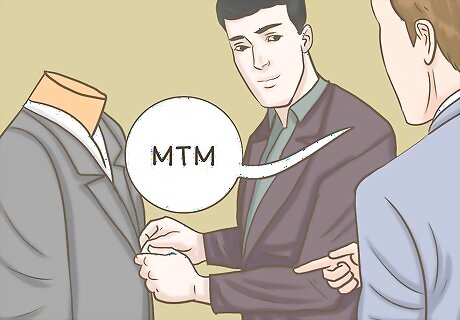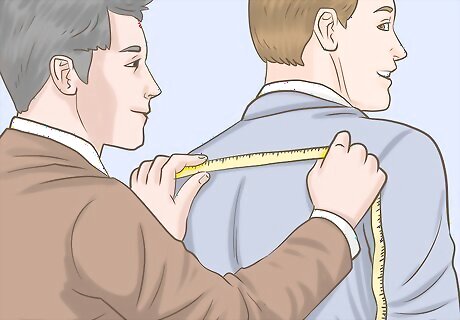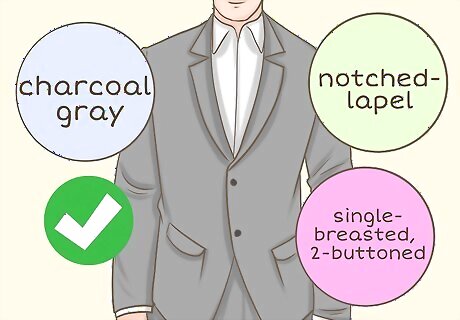
views
Shopping for Suits

Buy a suit off-the-rack, then get it tailored, for the budget option. If you’re looking to buy a suit without breaking the bank, off-the-rack is your best option. You can often get a good quality off-the-rack suit for $300-$500 USD. However, it’s always worth the extra $50-$100 USD to take it to a tailor’s shop for adjustments to fit you better. The closer you are to “average” size (in both height and weight), the better luck you’ll have with off-the-rack suits. Even if you’re perfectly average, though, no off-the-rack suit is going to fit you just right. You can buy off-the-rack suits for even cheaper, perhaps $100-$200 USD, but the craftsmanship is likely to be poor, meaning the suit won’t last nearly as long. EXPERT TIP "Always have your suits tailored. If your suit doesn't fit properly, it's not going to look good, no matter how much it cost." Candace Hanna Candace Hanna Professional Stylist Candace Hanna is a stylist and style expert based in Southern California. With 16 years of experience in the corporate fashion and personal styling realms, she runs Style by Candace, a personal styling agency that focuses on helping individuals find their personal expression through clothing. Her work has been featured in magazines such as Shoutout LA and VoyageLA. Candace Hanna Candace HannaProfessional Stylist

Try a made-to-measure (MTM) suit for a nice balance between fit and value. With MTM, an existing suit template will be tailored to fit you, typically based on 1-2 fittings. This means you’ll get a much better fit than off-the-rack, while not paying the exorbitant amount it costs to have a suit custom-made from scratch. MTM suits are machine-finished to fit your measurements, meaning you can get your suit with a fairly quick turnaround time—perhaps 2-4 weeks. MTM suits often start in the $500-$1000 USD range. Many major suit retailers now offer MTM options alongside their off-the-rack offerings.

Get a bespoke (custom-made) suit for an ultimate fit and a long-term investment. A bespoke suit is crafted from scratch, and primarily by hand, by a skilled tailor. You’ll have full control over the material and style of the suit, and you’ll typically take part in 5-10 fittings to make sure it fits you perfectly. A bespoke suit should last you for at least 20 years, and maybe many more. Since they’re precisely crafted to fit you, they’re also easier to adjust should your body proportions change over time. Bespoke suits can take months to craft, and the work comes at a cost. Expect to pay $3000-$5000, and possibly $10,000, for a custom-made suit. Keep in mind that they can easily last you a lifetime, though.

Try on suits you can’t afford before moving on to ones you can afford. Start your suit-buying excursion by heading to a few high-end suit retailers and checking out their selections. Even if you’re sure the price tags are beyond your means, take the time to note the construction, stylistic elements, and fit of pricey suits. Salespeople at high-end suit stores tend to be quite knowledgeable, so ask them for guidance for picking out a good suit. They’ll of course be eager to sell you something, so decide beforehand whether you’re willing to be talked into buying a $1500 suit.

Check for quality and be willing to pay for it. Once you’ve moved on to suits that are within your price range, keep a close eye out for signs of quality construction. Check for small details, like the stitching on and around buttons—sloppy work here is a sign of sloppy work overall. Cheaper suits may have glued linings instead of stitched. These won’t last nearly as long before separating or bubbling, and you’ll end up buying 2-3 suits in the period that a single good-quality suit will last you. Basically, buy the highest quality suit you can afford. For a first (off-the-rack) suit that you want to last for 10 years or more, aim for $500-$750 if possible. EXPERT TIP Alena Le Blanc Alena Le Blanc Personal Stylist Alena Le Blanc is the Personal Stylist and the Founder of Le Blanc Label. Based in San Francisco, California, Le Blanc Label is the leading personal stylist brand for sustainable style transformations. Alena and her team specialize in seasonal wardrobe refreshes, closet edits, styling for special events, travel, photoshoots, and general personal needs. Alena has been featured in podcasts including EMPOWERED BY WMN, I Am Fearless, and Mind Power Meets Mystic. Alena received her BFA in Fashion and Apparel Design from the Academy of Art University. Alena Le Blanc Alena Le Blanc Personal Stylist Invest in a quality suit for long-term use. Choose a suit crafted from durable fabric like wool or a high-thread-count cotton blend. Inspect the suit for neat stitches and smooth seams, signs of precise construction. Get a perfect fit for a sharp look. A well-made suit will boost your look and your confidence.

Make your first suit charcoal gray, single-breasted, 2-buttoned, and notched. Especially if you’re buying your first suit, this is a workhorse style that will serve you well in both more formal and less formal situations. Charcoal gray works equally well in the office, on a date, or at a funeral, as you can mix and match any array of colors in shirts, ties, shoes, and so on. The single-breasted, 2-button, 3 in (7.6 cm)-wide notched-lapel look is a nice balance between more and less formal. It works with a T-shirt and a bow tie. Navy blue is also a good choice, but not quite as universally functional as charcoal gray. Make this your second suit!
Choosing a Suit Style to Fit Your Needs

Figure out what you’ll be doing with the suit to narrow down your options. Do you need a suit you can wear to the office a few times a week, something for a specific event (like a wedding), or something you can pull out of your closet 3-4 times a year when needed? Make sure the suits you’re looking at are functional for your needs. If you’ll be wearing the suit regularly, prioritize quality construction (for instance, stitching instead of glued seams on the interior), ease-of-movement, and basic colors (like charcoal gray or navy blue) that match just about anything. When buying for more infrequent use, think about seasonality—that is, if you’ll be wearing the suit more often in warmer weather, opt for lighter fabrics like linen or cotton. For cooler weather, try heavier fabrics like tweed or cashmere.

Check out highly-structured, lightly-structured, and unstructured suits. Suits can range from a very rigid, military-like appearance to being so loose and free that they’re nearly shirt-like. Generally speaking, the more structured the suit is, the more formal it will look A highly-structured suit will essentially keep its shape once you take it off, while an unstructured one will lose its shape quite a bit. Lightly-structured suits provide a nice balance and are the most widely functional for both more formal and informal situations. They’ll generally keep their shape, but won’t look or feel rigid.

Compare buttons, lapels, and other more- and less-formal elements. Details like the number of buttons on the front of the jacket may at first seem trivial, but they go a long way toward determining the overall look your suit will present. For instance: Jackets can be single-breasted or double-breasted (in which one side overlaps the other). Double-breasted suits typically denote greater formality. Single-breasted jackets usually have 1, 2, or 3 buttons on the front, and more buttons typically make the suit look more formal. Double-breasted suits nearly always have 2 buttons. Lapels can be notched (with triangular cutouts near the collarbone), peaked (coming to upward-facing points), or rounded (carrying continuously around the neck and chest). Peaked lapels are typically considered more formal than notched, while the formality of rounded lapels depends more on the overall suit.
Checking Suits for Fit

Wear the clothes you’ll be wearing with a suit when trying them on. So, if you’ll be wearing your suit mainly with a collared shirt, tie, dress socks, and loafers, put these on when you go suit shopping. This way, you don’t have to try to visualize what the suit will look like as part of a full ensemble. Some suit retailers may have shoes, shirts, ties, and other accessories you can borrow while trying on suits, but you’re better off wearing your own items. If you need to buy these accessories as well, try them on and buy them along with your suit.

Make sure you can move freely in the suit. While slimmer-fitting suits have grown in popularity in recent years, a suit jacket should never feel like a straight jacket. While you don’t need to be able to do yoga in your suit, you should be able to raise your arms, sit comfortably, and perform typical everyday tasks in it without feeling constrained. For instance, even if you prefer to unbutton the jacket when you sit down, you shouldn’t be required to in order to be able to sit down. Likewise, your trousers shouldn’t cling or stretch when you sit. Good tailoring is very helpful here. Even if you buy off-the-rack, having a tailor adjust the suit to fit your body allows it to have a slim look without being too tight in key areas—such as under the arms or at the seat of the trousers.

Check that the fit at the shoulders and the coat length are correct. While a good tailor can work wonders with many elements of an off-the-rack suit, it’s very difficult to adjust the shoulders of the suit. Whether the shoulders are padded or not, they should drape naturally over your shoulders, and they shouldn’t stick out in the back beyond your own shoulder blades—try standing against a wall with your arms down to test this. Sleeve and trouser lengths are easy to adjust, but adjusting the length of the suit jacket itself is more challenging. Generally speaking, when you’re standing straight the jacket should completely but just barely cover your rear end.




















Comments
0 comment